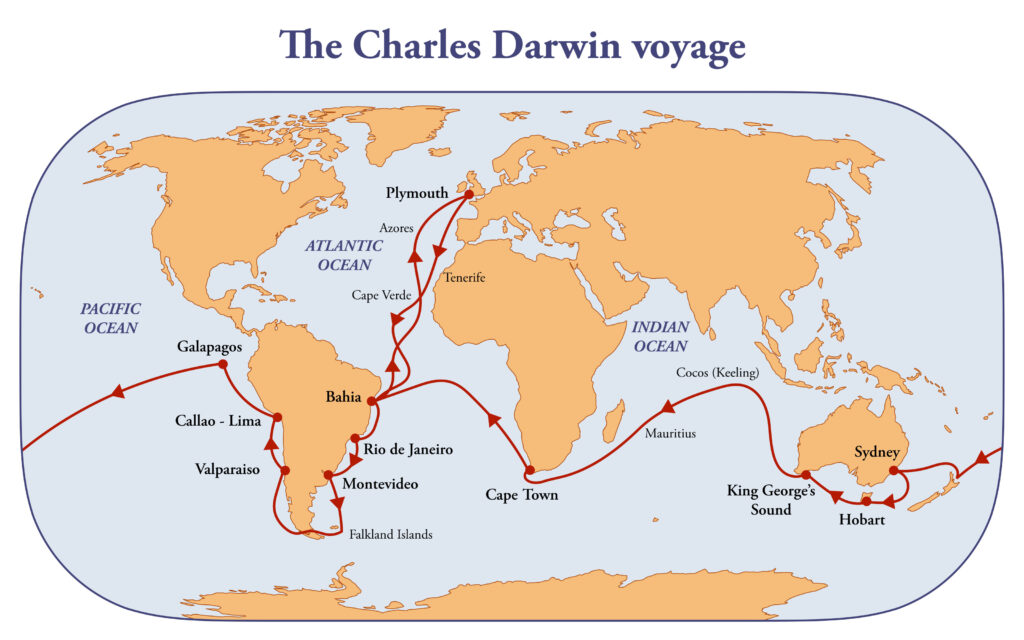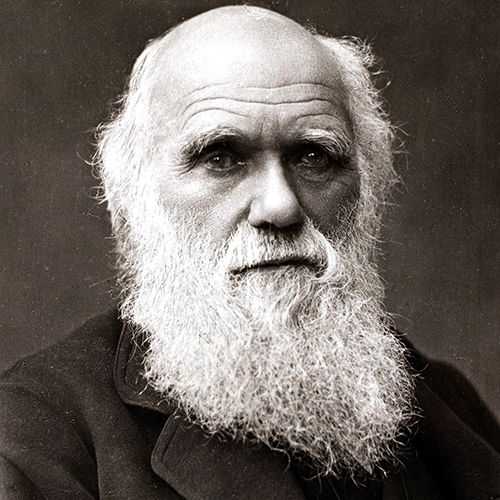Ever wondered how the brilliant minds behind some of the greatest scientific discoveries structured their day? What do their rituals and routines look like? Well, we did!
We are glad to share with you that today, we’re kicking off our new series “Daily Rituals of Scientists,” with the one and only Charles Darwin, the mastermind behind the theory of evolution. In this short read, you will catch a glimpse of the daily beat that powered his groundbreaking ideas and discoveries, but most importantly, the beneficial factors that you can incorporate in your life as well.
Early adventures
Charles Darwin’s early years were far from structured. In 1831, at just 22 years old, Darwin was offered the opportunity to serve as an unpaid naturalist on a survey expedition around the world. The name of the ship: HMS Beagle.
The famous HMS Beagle’s five-year journey was known for being full of surprises and adventures. Surrounded by the challenges of life at sea, his expeditions through the Brazilian jungles and the Andes Mountains left a mark, nurturing a newfound sense of purpose and deepening his understanding of the natural world. Darwin collected specimens of plants, animals and geological formations, getting a better grasp of the diversity of life on our planet. Fossil discoveries of ancient mammals further fueled his fascination with the earth’s past, igniting the spark that would later evolve into his groundbreaking theories, shaping the course of scientific history.

After concluding his voyage on the Beagle in 1837, Darwin briefly settled in London. However, his poor health and mounting stress compelled him to seek solace away from city life. It was during this period of transition that his early contemplations began to take shape, and when he, for the first time, sketched the theory of evolution in his famous red notebook. This was the beginning of the largest discovery of his life.
Moving away from the noise
In 1842, Charles Darwin moved away from the busy streets of London to the poise English countryside, where he remained until his death. During this time, he was secretly working on perhaps one of the important theories to date – the theory of evolution. Darwin knew that publishing his work was too risky at the time. He might get discredited and ridiculed for it. After all, people generally don’t like to be compared to animals. For him to refine this work and build credibility, he had to develop himself further as a scientist and a pioneer in the field. His work continued to blossom, and his discoveries got bigger, and bigger. But it wasn’t until almost 17 years later, that he finally published his prize work – On the Origin of Species.

Darwin had fragile health; he suffered from many serious symptoms, which cause was never known. Thus, he kept a quiet and structured life at Down House in an isolated village in Kent, or what he called – the “extreme edge of the world” (it turns out it’s only 28 km from London city center). The routine that follows describes the latter part of Darwin’s life, as told by his son, Francis Darwin.
Morning rituals: The foundation of a productive day
With the first rays of light, Darwin began his day with a brisk stroll, soaking in the wonders of nature. Darwin was a big fan of walks, and this morning one was just the first of many. By 7:45 a.m., he was enjoying a solitary breakfast, before jumping into his first work bout of the day. He would then spend approximately an hour and a half in his studies, considering this stretch as his prime thinking time.

At 9:30 a.m. – a break. Switching gears, Darwin would head to the drawing room with his wife, Emma (who was also his first cousin… just google it), to catch up on letters – a practice that kept him informed of the latest news and family updates. From 10:30, he would have another bout of focused work, lasting until noon, or a little past it. The end of this session signified most of Darwin’s “focused work” of the day. He would often even remark in a satisfied way: “It was a good day’s work”.
Midday musings and afternoon strolls
A firm believer in the restorative power of nature, Darwin embarked on another walk at noon. His path would often wind through the verdant expanse of the sandwalk, a cherished ritual that likely nurtured his love for the intricacies of the natural world.

Following a family lunch, Darwin indulged in leisurely activities. By 3 p.m., he could be found reclining in his bedroom, enjoying a cigarette and some light reading, often with the soothing voice of Emma narrating a novel or some delightful literature.
Evening contemplations and leisurely pursuits
As the day wound down, Darwin would venture out for yet another walk at 4 p.m. Sometimes, he would extend his stroll to more distant paths, having moments of introspection and inspiration. Post-walk, he returned to his study, embarking on the last and final set of work for the day – about an hour of tying up loose ends and preparing for the day’s end.
Evenings were dedicated to family time and relaxation. Darwin and Emma had 10 children (talking about evolutionary principles), which made for a very lively household. Light tea and good company filled the hours, often accompanied by games of backgammon with Emma. The night concluded with a session of personal reading and the soothing melodies of Emma’s piano, before retiring to bed. However, sleep often evaded the restless mind of this exceptional thinker, as he would often lay in bed for hours before falling asleep.

Lessons from Darwin’s rituals
Creativity and space
Charles Darwin’s routine might seem a bit “relaxed” by today’s standards. Three work bouts of 90 min in a day? Truth be told, it doesn’t seem much. However, his consistency and dedication to his work were obviously fruitful. Perhaps, for a brilliant mind to come up with the most creative ideas, time needs to be given to exploring and wondering. This time may not have been “productive” in itself, but Darwin’s creativity and keen sense of observation required time, patience and plenty of room for error. In the long run, the result was one of the most influential theories ever proposed. It puts into perspective the fast-paced and distracted lives we lead today.
Walks and optic flow
One of the most remarkable habits that tie many brilliant scientists together is the affinity for walks. Darwin would keep his rituals of having 3 walks a day, during which he used to ponder and think. There is something about walking outside that calls us out, and it might not be just fresh air and sunlight. It could be explained with the concept of Optic flow.
Optic flow is a phenomenon that occurs when we move forward, such as when walking, biking, or running. Visual images pass by our eyes, generating a flow of information that has a powerful effect on the nervous system. Optic flow has been shown to reduce the amount of neural activity in the amygdala, a brain structure that generates feelings of fear, threat, and anxiety. This could explain the feeling of free unburdened thinking and relaxation associated with walking, and perhaps why so many geniuses were fond of it!
Relationships
At last, relationships and family are essential. Darwin had 10 kids and spent quite a bit of time with them and his wife Emma. Maintaining social relationships and having someone to lean on who understands our struggles and goals can be very comforting and supportive and can give us the strength to go for those hard goals. Research also shows that it is one of the more important predictors of health and longevity!
Conclusion
Charles Darwin’s daily rhythm reveals the delicate dance between solitary contemplation, familial bonds, and the rejuvenating embrace of nature. His structured yet relaxed approach to each day highlights the importance of balancing work and leisure, demonstrating that genius often flourishes in the fertile soil of a well-rounded life. Hopefully, we can take something useful from a great scientist like Darwin, and incorporate it into our daily rituals.
What other rituals of scientists do you know and find interesting? Let us know!